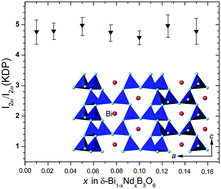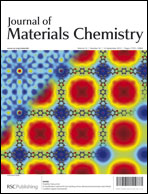Rare earth induced formation of δ-BiB3O6 at ambient pressure with strong second harmonic generation†
Abstract
Pure δ-BiB3O6, which is the polymorph of the most promising nonlinear optical (NLO) crystal α-BiB3O6 (BIBO), was first synthesized at high pressure/high temperature. δ-BiB3O6 possesses a non-centrosymmetric structure and moreover, its three-dimensional (3D) structure rather than 2D in BIBO suggests a high possibility to grow optical single-crystals. As an important candidate for NLO materials, we performed theoretical calculations of δ-BiB3O6 based on first principles. Surprisingly, it gives a significant higher second-harmonic generation (SHG) coefficient than previous experimental results (comparable to KDP), which greatly stimulates us to find a convenient synthesis method of the δ-phase at ambient pressure. In the present work, we report that rare-earth doping would stabilize the δ-phase at ambient pressure via a sol–gel method and the doping would reach quite a high level, δ-Bi1−xRExB3O6 (RE = La, Ce, Pr, Nd, 0 < x ≤ 0.15). The large miscibility is explained based on the structural similarity between δ-BiB3O6 and γ-REB3O6. The observed powder SHG signals are 4–6 times of KDP, consistent with our theoretical calculations. Furthermore the high level of Nd3+-doping might extend its applications to SFD or SSFM laser materials.


 Please wait while we load your content...
Please wait while we load your content...